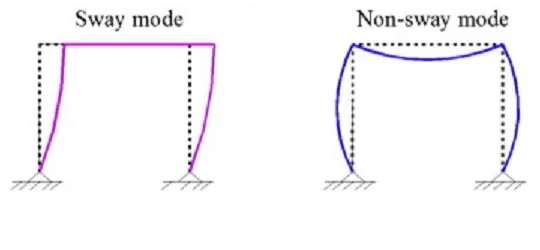In this blog post, we will discuss sway and non-sway frames.

Before starting the description of sway and non-sway frames, let’s get a brief idea about what is frame.
Table of Contents
What is Frame?
A frame is consists of several bars joined together in a particular manner. These bars are known as members.
Structural members under tension is known as Tie and under compression are known as Strut.
Here are some basic assumptions regarding framed structure.
- All structural members are pin jointed.
- The self-weight of the structural members is neglected.
- The frame can be jointed at the joints only.
Sway Frames
The frames in which longitudinal deflection takes place when the horizontal force is applied are known as sway frames.
Sway frames provide lateral resistance only through columns are considered to be sway frames.
Sway frames are unbraced frames.
Non-Sway Frames
In non-sway frames longitudinal deflection is restrained by supports when the horizontal load is applied.
It is sufficiently braced by lateral bracing elements like structural walls.
Non-sway frames are braced frames.
Certain conditions should meet when non-sway frames are cut into a two-piece.
- The loading should be symmetrical.
- The vertical length of structural members should be equal.
- Supports should be symmetrical.
- Given EI should be symmetrical.
Difference Between Sway and Non-Sway Frames
| Sway Frames | Non-Sway Frames |
|---|---|
| Sway frames are unbraced frames. | Non-sway frames are braced frames. |
| These frames lack adequate stiffness against horizontal loads. | Non-sway frames have enough stiffness to tackle with horizontal forces. |
| Loading is normally asymmetrical | Loading is normally symmetrical |
| Change of position of joints takes place due to lateral deflection. | Change of position of joints does not take place. |
| The second-order analysis is done. | The first-order analysis is done. |
| Sway frames may not have symmetrical EI, vertical lengths, and supports. | Non-sway frames always have symmetrical EI, vertical length, and support. |
| Sway frames are not much stable. | They are highly stable. |
Reasons for sway in the frame structure
- Non-uniform sections of the structural members.
- Presence of horizontal loading on a column of the frame structure.
- Various end conditions of the strut of the frame.
- Settlement of the backings or support of the frame.
- Eccentric loading (unsymmetrical loading).
